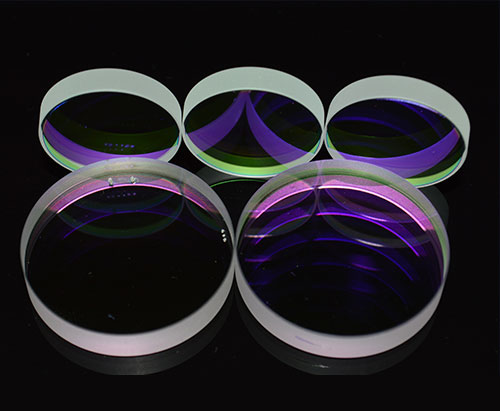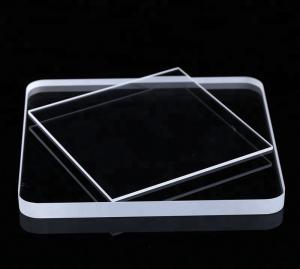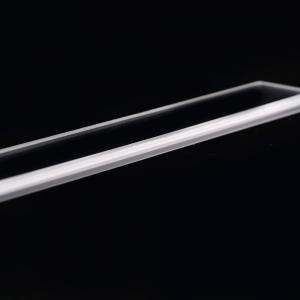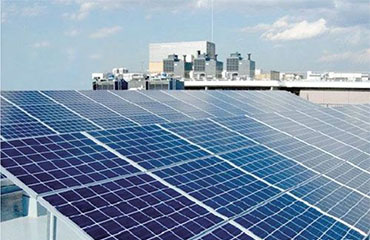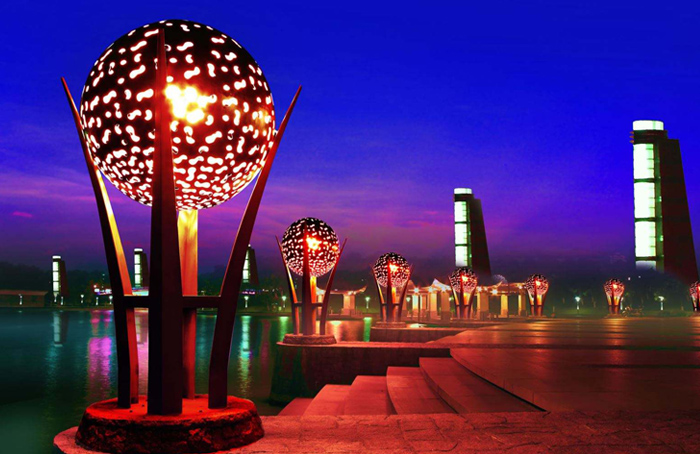
Chemical and physical properties of quartz
chemical properties
Fused quartz can withstand most liquids (metals, solutions and acids). Hydrofluoric acid and phosphoric acid can corrode fused quartz. Quartz glass can react with alkali metals and alkaline earth metals because alkali metals and intermetallic metals can promote the loss of permeability during the heating stage.
Quartz glass is made of very pure silicon dioxide. Other elements in this chain become impurities. Although the percentage of these impurities is very low, they have an important effect on quartz glass. Purity is determined by the raw materials used. Pollutants mainly come from production mode and treatment process. Pollution should be prevented at every stage of the production process in order to ensure purity.
The common impurities are metals, such as aluminium, sodium, iron and other impurities, water and chlorine, which are mainly in the glass grid and affect the viscous spectral absorption electrical properties. They also influence the characteristics of raw materials.
The purity of fused quartz and fused quartz is very high, and the metal content of synthetic quartz is less than 1 ppm. The fused quartz impurities are close to 20 ppm. The main pollutants are Al2O3, a few alkali metals, Fe2O3, Ti2 mGo ZrO 2.
Metal impurities mainly come from natural quartz, and very careful control of the processing process can greatly reduce the content of impurities, from 200 ppm to 20 ppm.
Aluminum is an impurity that replaces silicon atoms and exists in quartz glass. At high temperature, it has low activity, which makes it impossible to remove it at any stage of production.
hydroxyl
Hydroxyl content
In addition to metal impurities, fused quartz and fused quartz also contain some water hydroxyl groups, which enter the quartz grid will reduce the viscosity of quartz, so the temperature resistance of quartz is low. Other physical properties will also be affected, such as light transmittance, formation of absorption bands in infrared band. Each process has its typical hydroxyl content, which is 1-30 ppm lower than that of electrofusion because it melts in vacuum or under negative pressure. During annealing, humidity can also affect the content of hydroxyl in gasified quartz, because gasified quartz melts to synthesize quartz by hydrogen-oxygen flame. The hydroxyl content of synthesized quartz is reduced by flame hydrolysis of chemical substance with hydroxyl content greater than 1000ppm, and the hydroxyl content of synthesized quartz can be treated by high temperature chlorination.
physical characteristics
Because of its high purity and micro-structure, glass has more characteristics. Quartz glass has low thermal conductivity, low expansion coefficient, high thermal shock and insulation. There is also low thermal conductivity. Quartz glass has a high tensile strength, which depends on the surface conditions of the glass in practice. Under the action of tensile force, small defects, such as scratches, will lead to the breakage of glass grid structure, which will lead to the breakage of glass, fused quartz and fused quartz are good insulators that can not conduct electrons and can conduct ions. All external ions in the glass grid contribute to conduction, and the sensationality of ions has been associated with charge and electron size temperatures. With the increase of temperature, the resistance of quartz glass decreases and the activity of electrons increases. The lower the impurity content, the smaller the conductivity of quartz. Quartz glass has light that can pass through many bands, ranging from 0.18 micron to 3.5 micron. How much it absorbs at 2.73 micron depends on the magnitude of OH value. The appearance of infrared peaks is due to lattice vibration and glass thickness. The location of the ultraviolet absorption peak depends on the chemical elements in the glass grid.
Fused quartz can withstand most liquids (metals, solutions and acids). Hydrofluoric acid and phosphoric acid can corrode fused quartz. Quartz glass can react with alkali metals and alkaline earth metals because alkali metals and intermetallic metals can promote the loss of permeability during the heating stage.
Quartz glass is made of very pure silicon dioxide. Other elements in this chain become impurities. Although the percentage of these impurities is very low, they have an important effect on quartz glass. Purity is determined by the raw materials used. Pollutants mainly come from production mode and treatment process. Pollution should be prevented at every stage of the production process in order to ensure purity.
The common impurities are metals, such as aluminium, sodium, iron and other impurities, water and chlorine, which are mainly in the glass grid and affect the viscous spectral absorption electrical properties. They also influence the characteristics of raw materials.
The purity of fused quartz and fused quartz is very high, and the metal content of synthetic quartz is less than 1 ppm. The fused quartz impurities are close to 20 ppm. The main pollutants are Al2O3, a few alkali metals, Fe2O3, Ti2 mGo ZrO 2.
Metal impurities mainly come from natural quartz, and very careful control of the processing process can greatly reduce the content of impurities, from 200 ppm to 20 ppm.
Aluminum is an impurity that replaces silicon atoms and exists in quartz glass. At high temperature, it has low activity, which makes it impossible to remove it at any stage of production.
hydroxyl
Hydroxyl content
In addition to metal impurities, fused quartz and fused quartz also contain some water hydroxyl groups, which enter the quartz grid will reduce the viscosity of quartz, so the temperature resistance of quartz is low. Other physical properties will also be affected, such as light transmittance, formation of absorption bands in infrared band. Each process has its typical hydroxyl content, which is 1-30 ppm lower than that of electrofusion because it melts in vacuum or under negative pressure. During annealing, humidity can also affect the content of hydroxyl in gasified quartz, because gasified quartz melts to synthesize quartz by hydrogen-oxygen flame. The hydroxyl content of synthesized quartz is reduced by flame hydrolysis of chemical substance with hydroxyl content greater than 1000ppm, and the hydroxyl content of synthesized quartz can be treated by high temperature chlorination.
physical characteristics
Because of its high purity and micro-structure, glass has more characteristics. Quartz glass has low thermal conductivity, low expansion coefficient, high thermal shock and insulation. There is also low thermal conductivity. Quartz glass has a high tensile strength, which depends on the surface conditions of the glass in practice. Under the action of tensile force, small defects, such as scratches, will lead to the breakage of glass grid structure, which will lead to the breakage of glass, fused quartz and fused quartz are good insulators that can not conduct electrons and can conduct ions. All external ions in the glass grid contribute to conduction, and the sensationality of ions has been associated with charge and electron size temperatures. With the increase of temperature, the resistance of quartz glass decreases and the activity of electrons increases. The lower the impurity content, the smaller the conductivity of quartz. Quartz glass has light that can pass through many bands, ranging from 0.18 micron to 3.5 micron. How much it absorbs at 2.73 micron depends on the magnitude of OH value. The appearance of infrared peaks is due to lattice vibration and glass thickness. The location of the ultraviolet absorption peak depends on the chemical elements in the glass grid.
-
Last article: It's the first one.
Next article: Quartz glass is composed of a single oxide.
 0086 13905125665
0086 13905125665  Contact person: Zhang Dongguang
Contact person: Zhang Dongguang 


